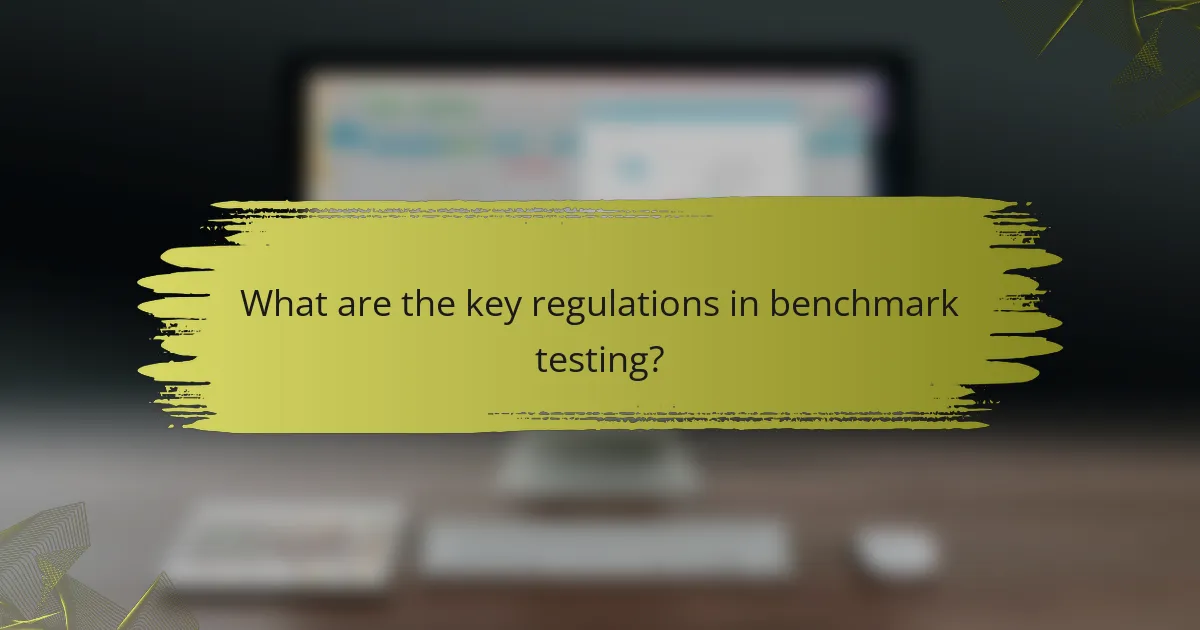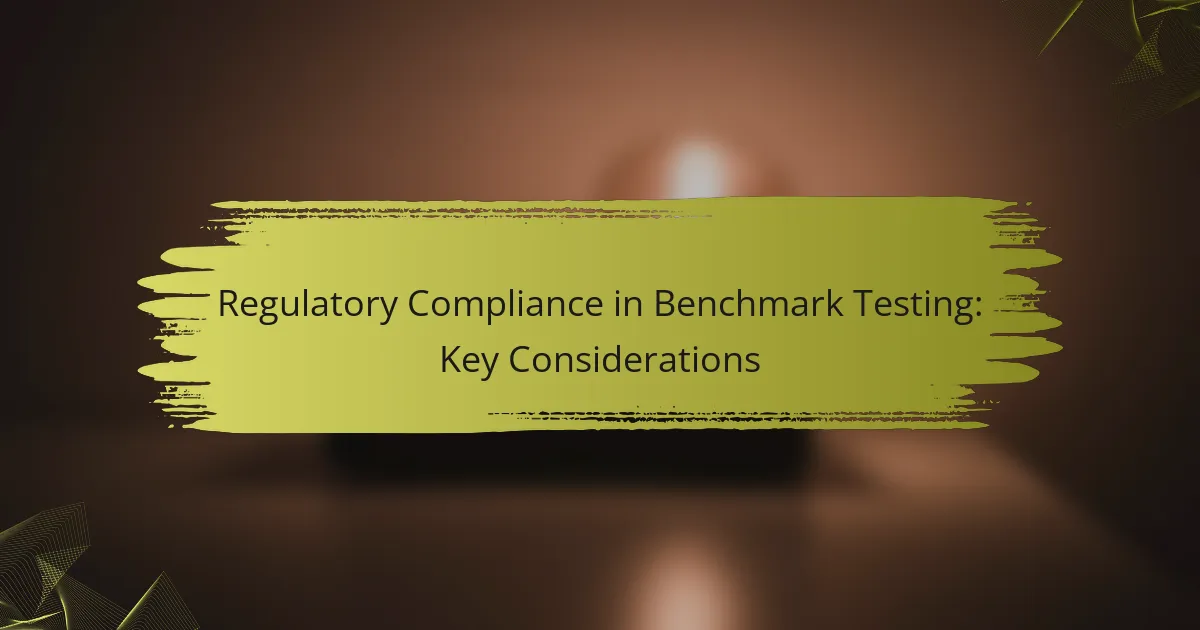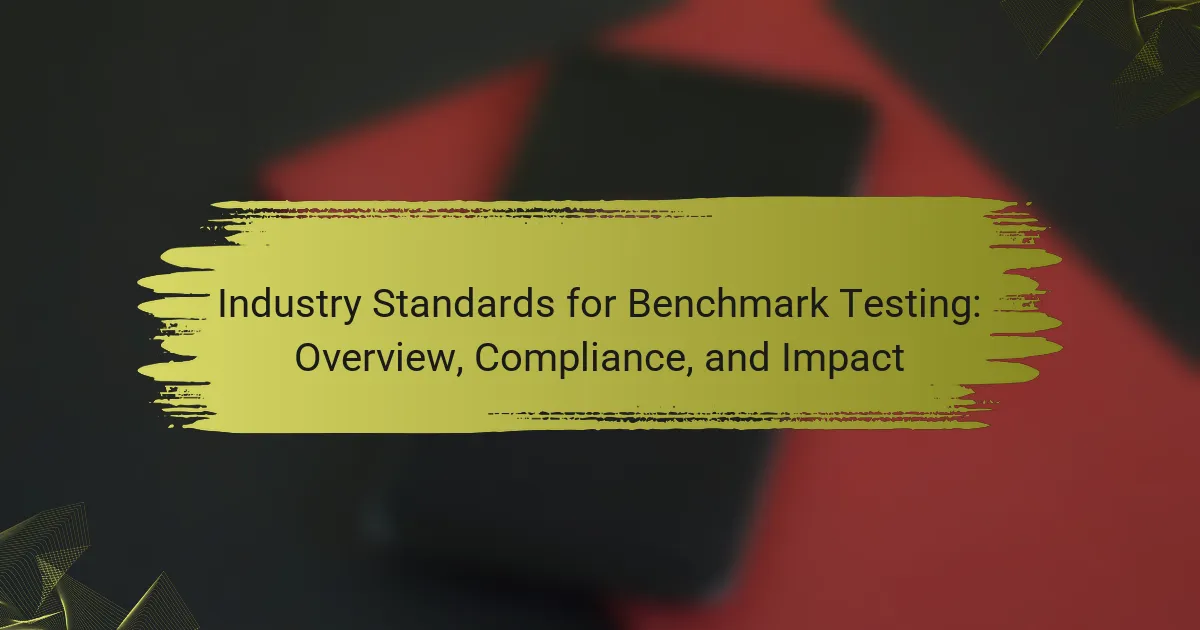Regulatory compliance in benchmark testing is essential for manufacturers to ensure their products meet industry standards for quality and safety. Adhering to established regulations not only validates testing processes but also facilitates market access. Organizations must implement robust quality management systems and conduct regular audits to navigate the complexities of compliance while mitigating risks.

What are the key regulations in benchmark testing?
Key regulations in benchmark testing ensure that products meet industry standards for quality and safety. Compliance with these regulations is crucial for manufacturers to validate their testing processes and maintain market access.
ISO/IEC 17025 standards
ISO/IEC 17025 outlines the requirements for testing and calibration laboratories to demonstrate their competence. This standard focuses on ensuring that laboratories produce valid and reliable results, which is essential in benchmark testing.
To comply with ISO/IEC 17025, laboratories must implement a quality management system, maintain proper documentation, and regularly participate in proficiency testing. Regular audits and assessments are also necessary to ensure ongoing compliance.
FDA guidelines for medical devices
The FDA provides specific guidelines for benchmark testing of medical devices to ensure safety and effectiveness. These guidelines require manufacturers to conduct rigorous testing and provide substantial evidence of their device’s performance before market approval.
Key considerations include the need for clinical evaluations, risk assessments, and adherence to Good Manufacturing Practices (GMP). Manufacturers should also be aware of the premarket notification (510(k)) process, which may require comparative testing against predicate devices.
EU regulations on product testing
In the European Union, product testing is governed by various regulations, including the General Product Safety Directive and specific directives for different product categories. Compliance with these regulations is mandatory for products sold within the EU market.
Manufacturers must ensure that their products meet safety requirements and undergo appropriate testing procedures. This often involves obtaining CE marking, which indicates conformity with EU standards. Regular updates to regulations mean that staying informed is crucial for compliance.

How to ensure compliance in benchmark testing?
To ensure compliance in benchmark testing, organizations must adhere to established standards and regulations while implementing robust processes. This involves integrating quality management systems, conducting regular audits, and training staff on compliance protocols to mitigate risks and enhance reliability.
Implementing quality management systems
Quality management systems (QMS) are essential for maintaining compliance in benchmark testing. A well-structured QMS helps organizations define processes, set quality objectives, and ensure consistent performance. Consider adopting frameworks like ISO 9001, which provides guidelines for effective quality management.
Key components of a QMS include documentation of procedures, regular monitoring of performance metrics, and continuous improvement initiatives. By establishing a QMS, organizations can systematically address compliance requirements and enhance the integrity of their benchmark testing processes.
Regular audits and assessments
Conducting regular audits and assessments is crucial for identifying compliance gaps in benchmark testing. These evaluations should be scheduled at least annually and can include both internal and external reviews. Audits help ensure that testing procedures align with regulatory standards and organizational policies.
During audits, focus on verifying documentation, assessing the effectiveness of the QMS, and evaluating test results against benchmarks. Implementing corrective actions based on audit findings can significantly improve compliance and operational efficiency.
Training staff on compliance protocols
Training staff on compliance protocols is vital for fostering a culture of accountability in benchmark testing. Employees should be well-versed in relevant regulations, testing methodologies, and quality standards. Regular training sessions can help reinforce compliance expectations and update staff on any changes in regulations.
Consider developing a comprehensive training program that includes workshops, online courses, and hands-on training. Providing resources and support will empower staff to adhere to compliance protocols effectively, reducing the risk of non-compliance and enhancing overall testing quality.

What are the common challenges in regulatory compliance?
Common challenges in regulatory compliance include staying updated with evolving regulations, effectively allocating resources for compliance activities, and deciphering complex regulatory language. These obstacles can hinder organizations from meeting compliance standards and maintaining operational efficiency.
Keeping up with changing regulations
Regulatory environments are dynamic, often changing due to new laws, amendments, or industry standards. Organizations must establish a systematic approach to monitor these changes, which may involve subscribing to regulatory updates or engaging compliance experts.
To effectively keep up, consider implementing a compliance management system that tracks regulatory changes relevant to your industry. Regular training sessions for staff can also ensure that everyone is aware of the latest requirements.
Resource allocation for compliance efforts
Allocating sufficient resources for compliance is crucial yet challenging. Organizations often struggle to balance compliance costs with operational budgets, leading to underfunded compliance programs.
To optimize resource allocation, conduct a risk assessment to identify high-priority compliance areas. This can help in justifying budget requests and ensuring that resources are directed where they are most needed.
Understanding complex regulatory language
Regulatory documents often contain jargon and complex language that can be difficult to interpret. Misunderstanding these regulations can lead to non-compliance and potential penalties.
To navigate this complexity, consider investing in training for staff or hiring legal experts who specialize in regulatory compliance. Creating a glossary of key terms can also aid in demystifying regulatory language for your team.

What frameworks can help in compliance management?
Several frameworks can assist organizations in managing compliance effectively, ensuring adherence to regulations and standards. These frameworks provide structured approaches to identify, assess, and mitigate compliance risks while streamlining processes.
Risk management frameworks
Risk management frameworks are essential for identifying and addressing compliance risks within an organization. Popular frameworks like ISO 31000 and COSO ERM provide guidelines for establishing a risk management process that aligns with business objectives.
When implementing a risk management framework, consider conducting regular risk assessments to identify potential compliance gaps. This proactive approach helps in prioritizing risks and allocating resources effectively to mitigate them.
Compliance checklists and templates
Compliance checklists and templates serve as practical tools for ensuring that all necessary compliance requirements are met. These resources can help organizations systematically review their processes against regulatory standards, such as GDPR or HIPAA.
Utilizing checklists can streamline compliance audits and ensure that no critical steps are overlooked. For example, a checklist for GDPR compliance might include data processing agreements, privacy notices, and user consent mechanisms.

How does benchmark testing vary across industries?
Benchmark testing varies significantly across industries due to differing regulatory requirements, standards, and performance metrics. Each sector has unique considerations that influence how benchmarks are established and evaluated.
Pharmaceutical industry requirements
In the pharmaceutical industry, benchmark testing is crucial for ensuring drug safety and efficacy. Regulatory bodies like the FDA in the United States require rigorous testing protocols, including preclinical and clinical trials, to establish benchmarks for drug performance.
Key considerations include adherence to Good Clinical Practice (GCP) and Good Manufacturing Practice (GMP) standards. Companies must document all testing procedures and results meticulously to comply with regulatory expectations and facilitate approval processes.
Automotive industry standards
The automotive industry relies on benchmark testing to meet safety and performance standards set by organizations such as the National Highway Traffic Safety Administration (NHTSA) in the U.S. and the European New Car Assessment Programme (Euro NCAP). These benchmarks assess vehicle safety, emissions, and fuel efficiency.
Manufacturers must conduct crash tests, emissions tests, and durability assessments to ensure compliance with regulations. Regular updates to standards mean that companies should continuously monitor changes and adapt their testing protocols accordingly.
Information technology compliance
In the information technology sector, benchmark testing focuses on system performance, security, and compliance with standards like ISO 27001 for information security management. Organizations often conduct performance benchmarks to evaluate software and hardware efficiency under varying loads.
Compliance with regulations such as GDPR in Europe or HIPAA in the U.S. requires IT systems to undergo rigorous testing to ensure data protection and privacy. Regular audits and assessments help maintain compliance and identify areas for improvement.

What are the emerging trends in regulatory compliance?
Emerging trends in regulatory compliance include increased automation, the use of artificial intelligence for monitoring, and a heightened focus on sustainability and ethical standards. These trends are reshaping how organizations approach compliance, making processes more efficient and aligned with modern expectations.
Increased automation in compliance processes
Automation in compliance processes streamlines tasks such as data collection, reporting, and monitoring. By utilizing software solutions, organizations can reduce manual errors and save time, allowing compliance teams to focus on more strategic activities.
For example, automated systems can generate compliance reports in real-time, ensuring that organizations meet regulatory deadlines without the burden of extensive manual input. This trend is particularly beneficial for industries with complex regulatory environments, such as finance and healthcare.
Use of AI for regulatory monitoring
Artificial intelligence is increasingly being used for regulatory monitoring, enabling organizations to analyze vast amounts of data quickly and accurately. AI can identify patterns and anomalies that may indicate compliance risks, allowing for proactive management.
For instance, AI-driven tools can monitor transactions for signs of fraud or non-compliance with regulations like the GDPR or AML laws. By leveraging AI, companies can enhance their compliance capabilities while reducing the resources needed for traditional monitoring methods.
Focus on sustainability and ethical standards
There is a growing emphasis on sustainability and ethical standards within regulatory compliance frameworks. Organizations are now expected to not only comply with legal requirements but also to adopt practices that promote environmental responsibility and social governance.
Companies may implement sustainability audits and ethical sourcing policies to align with these expectations. This shift not only helps in meeting regulatory demands but also enhances brand reputation and customer trust, which are increasingly important in today’s market.



